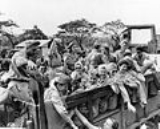
Angels of Bataan
Encyclopedia
The Angels of Bataan were the members of the United States Army Nurse Corps and the United States Navy Nurse Corps
who were stationed in the Philippines at the outset of the Pacific War
and served during the Battle of the Philippines (1941–42). When Bataan and Corregidor fell, 11 Navy nurses, 66 army nurses, and 1 nurse-anesthetist were captured and imprisoned in and around Manila. They continued to serve as a nursing unit throughout their status as prisoners of war
. After years of hardship, they were finally liberated in February 1945.
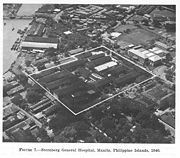 The navy nurses, under the command of Lt. Laura M. Cobb
The navy nurses, under the command of Lt. Laura M. Cobb
, stayed behind in Manila during the initial invasion to support the patients there. One of them, Ann A. Bernatitus
, escaped from Manila to Bataan just before Manila fell. The remaining 11 navy nurses were captured upon the fall of Manila and interned by the Japanese at Santo Tomas.
The Army nurses, under the command of Capt. Maude Davison, together with Navy nurse Bernatitus, escaped from Manila and went on to serve in the Battle of Bataan
and the Battle of Corregidor
.
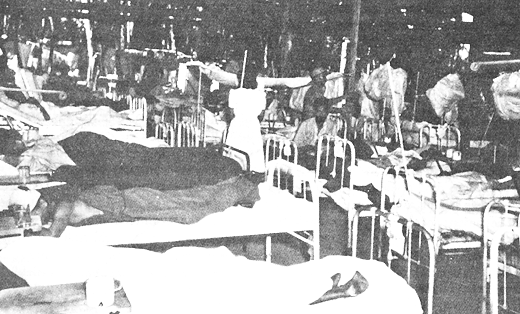 Just prior to the fall of Bataan on 9 April 1942, the nurses serving there were ordered to the island fortress of Corregidor by General Wainwright
Just prior to the fall of Bataan on 9 April 1942, the nurses serving there were ordered to the island fortress of Corregidor by General Wainwright
(commander of the forces in the Philippines after MacArthur was ordered to Australia).
.
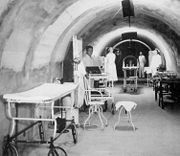
. On 3 May, the sole Navy nurse, Ann Bernatitus
, a few more army nurses, and a small group of civilians were evacuated aboard the submarine .
on 6 May, the remaining nurses were captured and — on 2 July — transferred to the Santo Tomas Internment Camp.
was converted to an internment camp by the Japanese during their occupation of the Philippines. The camp is described in detail in The War
by Ken Burns
. In addition to its civilian population, Santo Tomas became the initial internment camp for both the army and navy nurses, with the army nurses remaining there until their liberation.
Capt. Maude C. Davison, 57 years old and with 20 years of service experience, took command of the nurses, maintained a regular schedule of nursing duty, and insisted that all nurses wear their khaki blouses and skirts while on duty.
, were transferred to a new internment camp at Los Baños, where they established a new infirmary and continued working as a nursing unit. At Los Baños they came to be known as "the sacred eleven."
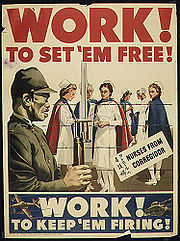 Lt. Juanita Redmond, one of the few nurses to escape, published a memoir of her experiences on Bataan in 1943 that concluded with a dramatic reminder that her colleagues were still prisoners. The nurses' story was dramatized in several wartime movies, including:
Lt. Juanita Redmond, one of the few nurses to escape, published a memoir of her experiences on Bataan in 1943 that concluded with a dramatic reminder that her colleagues were still prisoners. The nurses' story was dramatized in several wartime movies, including:
When So Proudly We Hail! was shown in the theaters, a recruitment booth staffed with Red Cross volunteers was set up in the lobby.
, with whom it remained until the camp was liberated. Access to outside food sources was curtailed, the diet of the internees was reduced to 960 calories per person per day by November 1944, and further reduced to 700 calories per person per day by January 1945.
A Department of Veterans Affairs study released in April, 2002 found that the nurses lost, on average, 30% of their body weight during internment, and subsequently experienced a degree of service-connected disability "virtually the same as the male ex-POW's of the Pacific Theater." Maude C. Davison's body weight dropped from 156 lbs. to 80 lbs.
, General Douglas MacArthur
ordered Major General Vernon D. Mudge to make an aggressive raid on Santo Tomas in the Battle of Manila (1945). The internees at Santo Tomas, including the nurses, were liberated on 3 February 1945, by a "flying column" of the 1st Cavalry.
The navy nurses were subsequently liberated in the Raid at Los Baños
.
Upon returning to the U.S., the US Army awarded their nurses, among other decorations, the Bronze Star
for valor and a Presidential Unit Citation for extraordinary heroism in action. The Navy nurses were likewise awarded Bronze Stars upon their return.
shrine by men who survived Bataan and Corregidor. It reads:
Maj. Maude C. Davison, credited by many for keeping the army nurses alive by her insistence on the nurses maintaining their identity as nurses throughout their internment, was posthumously awarded the Distinguished Service Medal
on August 20, 2001. A similar effort has not yet been undertaken for Chief Nurse Laura M. Cobb
.
United States Navy Nurse Corps
The United States Navy Nurse Corps was officially established by Congress in 1908; however, unofficially, women had been working as nurses aboard Navy ships and in Navy hospitals for nearly 100 years.-Pre-1908:...
who were stationed in the Philippines at the outset of the Pacific War
Pacific War
The Pacific War, also sometimes called the Asia-Pacific War refers broadly to the parts of World War II that took place in the Pacific Ocean, its islands, and in East Asia, then called the Far East...
and served during the Battle of the Philippines (1941–42). When Bataan and Corregidor fell, 11 Navy nurses, 66 army nurses, and 1 nurse-anesthetist were captured and imprisoned in and around Manila. They continued to serve as a nursing unit throughout their status as prisoners of war
Prisoner of war
A prisoner of war or enemy prisoner of war is a person, whether civilian or combatant, who is held in custody by an enemy power during or immediately after an armed conflict...
. After years of hardship, they were finally liberated in February 1945.
In Manila
At the outset of World War II, US Army and US Navy nurses were stationed at Sternberg General Hospital in Manila, and other military hospitals around Manila. During the Battle of the Philippines (1941–42), eighty-eight US Army nurses escaped, in the last week of December 1941, to Corregidor and Bataan.
Laura M. Cobb
Laura Mae Cobb was a member of the United States Navy Nurse Corps who served during World War II. She received numerous decorations for her actions during the defense of Manila and her 37 months as a POW of the Japanese, during which she continued to serve as Chief Nurse for ten other imprisoned...
, stayed behind in Manila during the initial invasion to support the patients there. One of them, Ann A. Bernatitus
Ann A. Bernatitus
Ann Agnes Bernatitus was a United States Navy nurse who served during World War II. In October 1942, she became the first American recipient of the Legion of Merit for her heroism during the siege of Bataan and Corregidor from December 1941 through April 1942...
, escaped from Manila to Bataan just before Manila fell. The remaining 11 navy nurses were captured upon the fall of Manila and interned by the Japanese at Santo Tomas.
The Army nurses, under the command of Capt. Maude Davison, together with Navy nurse Bernatitus, escaped from Manila and went on to serve in the Battle of Bataan
Battle of Bataan
The Battle of Bataan represented the most intense phase of Imperial Japan's invasion of the Philippines during World War II. The capture of the Philippine Islands was crucial to Japan's effort to control the Southwest Pacific, seize the resource-rich Dutch East Indies, and protect its Southeast...
and the Battle of Corregidor
Battle of Corregidor
The Battle for Corregidor was the culmination of the Japanese campaign for the conquest of the Philippines. The fall of Bataan on 9 April 1942 ended all organized opposition by the U.S...
.
On Bataan
In late December 1941, many of the nurses were assigned to a pair of battlefield hospitals on Bataan named Hospital #1 and Hospital #2. These hospitals included the first open-air wards in US history since the Civil War. Tropical diseases, including malaria and dysentery, were widespread among both hospital patients and staff.
Jonathan Mayhew Wainwright IV
Jonathan Mayhew "Skinny" Wainwright IV was a career American army officer and the commander of Allied forces in the Philippines at the time of their surrender to the Empire of Japan during World War II...
(commander of the forces in the Philippines after MacArthur was ordered to Australia).
On Corregidor
During the Battle of Corregidor, the nurses were stationed in the hospital and wards in the maze of underground tunnels connected to the Malinta TunnelMalinta Tunnel
The Malinta Tunnel is a tunnel complex built by the United States Army Corps of Engineers on the island of Corregidor in the Philippines. It was initially used as a bomb-proof storage and personnel bunker, but was later equipped as a 1,000-bed hospital. The main tunnel, running east to west, is ...
.

A Few Escape
On 29 April, a small group of army nurses were evacuated, with other passengers, aboard a navy PBY CatalinaPBY Catalina
The Consolidated PBY Catalina was an American flying boat of the 1930s and 1940s produced by Consolidated Aircraft. It was one of the most widely used multi-role aircraft of World War II. PBYs served with every branch of the United States Armed Forces and in the air forces and navies of many other...
. On 3 May, the sole Navy nurse, Ann Bernatitus
Ann A. Bernatitus
Ann Agnes Bernatitus was a United States Navy nurse who served during World War II. In October 1942, she became the first American recipient of the Legion of Merit for her heroism during the siege of Bataan and Corregidor from December 1941 through April 1942...
, a few more army nurses, and a small group of civilians were evacuated aboard the submarine .
Fall of Corregidor
When Corregidor fell to Japanese forces under the command of General Masaharu HommaMasaharu Homma
was a general in the Imperial Japanese Army. He is noteworthy for his role in the invasion and occupation of the Philippines during World War II. Homma, who was an amateur painter and playwright, was also known as the Poet General.-Biography:...
on 6 May, the remaining nurses were captured and — on 2 July — transferred to the Santo Tomas Internment Camp.
At Santo Tomas
The campus of the University of Santo TomasUniversity of Santo Tomas
The Pontifical and Royal University of Santo Tomas, The Catholic University of the Philippines , is a private Roman Catholic university run by the Order of Preachers in Manila. Founded on April 28, 1611 by archbishop of Manila Miguel de Benavides, it has the oldest extant university charter in the...
was converted to an internment camp by the Japanese during their occupation of the Philippines. The camp is described in detail in The War
The War (documentary)
The War is a 2007 American seven-part documentary television mini-series about World War II from the perspective of the United States that premiered on September 23, 2007...
by Ken Burns
Ken Burns
Kenneth Lauren "Ken" Burns is an American director and producer of documentary films, known for his style of using archival footage and photographs...
. In addition to its civilian population, Santo Tomas became the initial internment camp for both the army and navy nurses, with the army nurses remaining there until their liberation.
Capt. Maude C. Davison, 57 years old and with 20 years of service experience, took command of the nurses, maintained a regular schedule of nursing duty, and insisted that all nurses wear their khaki blouses and skirts while on duty.
At Los Baños
In May 1943, the navy nurses, still under the command of Lt. CobbLaura M. Cobb
Laura Mae Cobb was a member of the United States Navy Nurse Corps who served during World War II. She received numerous decorations for her actions during the defense of Manila and her 37 months as a POW of the Japanese, during which she continued to serve as Chief Nurse for ten other imprisoned...
, were transferred to a new internment camp at Los Baños, where they established a new infirmary and continued working as a nursing unit. At Los Baños they came to be known as "the sacred eleven."
On the Home Front
While the capture of the nurses was widely publicized in the U.S., little specific information was known of their fate until they were liberated.
- Cry 'Havoc'Cry 'Havoc'This article is about the 1943 motion picture. For the board game see Cry Havoc.Cry 'Havoc' is a 1943 American drama film, produced by MGM and directed by Richard Thorpe...
(MGM 1943) - So Proudly We Hail!So Proudly We Hail!So Proudly We Hail! is a 1943 film directed by Mark Sandrich, and starring Claudette Colbert, Paulette Goddard – who was nominated for an Academy Award for Best Supporting Actress for her performance – and Veronica Lake...
(Paramount 1943) (based on the Redmond book) - They Were ExpendableThey Were ExpendableThey Were Expendable is a 1945 American war film directed by John Ford and starring Robert Montgomery and John Wayne. The film is based on the book by William L. White, relating the story of the exploits of Motor Torpedo Boat Squadron Three, a PT boat unit defending the Philippines against Japanese...
(MGM 1945)
When So Proudly We Hail! was shown in the theaters, a recruitment booth staffed with Red Cross volunteers was set up in the lobby.
Final year of Internment
In January 1944, control of the Santo Tomas Internment Camp changed from Japanese civil authorities to the Imperial Japanese ArmyImperial Japanese Army
-Foundation:During the Meiji Restoration, the military forces loyal to the Emperor were samurai drawn primarily from the loyalist feudal domains of Satsuma and Chōshū...
, with whom it remained until the camp was liberated. Access to outside food sources was curtailed, the diet of the internees was reduced to 960 calories per person per day by November 1944, and further reduced to 700 calories per person per day by January 1945.
A Department of Veterans Affairs study released in April, 2002 found that the nurses lost, on average, 30% of their body weight during internment, and subsequently experienced a degree of service-connected disability "virtually the same as the male ex-POW's of the Pacific Theater." Maude C. Davison's body weight dropped from 156 lbs. to 80 lbs.
Liberation
Emboldened by the success of the Raid at CabanatuanRaid at Cabanatuan
The Raid at Cabanatuan was a rescue of Allied prisoners of war and civilians from a Japanese camp near Cabanatuan City, in the Philippines...
, General Douglas MacArthur
Douglas MacArthur
General of the Army Douglas MacArthur was an American general and field marshal of the Philippine Army. He was a Chief of Staff of the United States Army during the 1930s and played a prominent role in the Pacific theater during World War II. He received the Medal of Honor for his service in the...
ordered Major General Vernon D. Mudge to make an aggressive raid on Santo Tomas in the Battle of Manila (1945). The internees at Santo Tomas, including the nurses, were liberated on 3 February 1945, by a "flying column" of the 1st Cavalry.
The navy nurses were subsequently liberated in the Raid at Los Baños
Raid at Los Baños
The raid at Los Baños in the Philippines, early Friday morning on 23 February 1945, was executed by a combined U.S. Army Airborne and Filipino guerrilla task force, resulting in the liberation of 2,147 Allied civilian and military internees from an agricultural school campus turned Japanese...
.
Upon returning to the U.S., the US Army awarded their nurses, among other decorations, the Bronze Star
Bronze Star Medal
The Bronze Star Medal is a United States Armed Forces individual military decoration that may be awarded for bravery, acts of merit, or meritorious service. As a medal it is awarded for merit, and with the "V" for valor device it is awarded for heroism. It is the fourth-highest combat award of the...
for valor and a Presidential Unit Citation for extraordinary heroism in action. The Navy nurses were likewise awarded Bronze Stars upon their return.
Memorial and Recognition
On April 9, 1980, a bronze plaque was dedicated at the Mount SamatMount Samat
Mount Samat is a mountain in the town of Pilar, Province of Bataan, in the Republic of the Philippines. Located on the summit of the mountain is Dambana ng Kagitingan or Shrine of Valour, a memorial shrine complex built to honor and remember the gallantry of the Filipino and American soldiers who...
shrine by men who survived Bataan and Corregidor. It reads:
TO THE ANGELS-- In honor of the valiant American military women who gave so much of themselves in the early days of World War II. They provided care and comfort to the gallant defenders of Bataan and Corregidor. They lived on a starvation diet, shared the bombing, strafing, sniping, sickness and disease while working endless hours of heartbreaking duty. These nurses always had a smile, a tender touch and a kind word for their patients. They truly earned the name--THE ANGELS OF BATAAN AND CORREGIDOR."
Maj. Maude C. Davison, credited by many for keeping the army nurses alive by her insistence on the nurses maintaining their identity as nurses throughout their internment, was posthumously awarded the Distinguished Service Medal
Distinguished Service Medal (Army)
The Distinguished Service Medal is a military award of the United States Army that is presented to any person who, while serving in any capacity with the United States military, has distinguished himself or herself by exceptionally meritorious service to the Government in a duty of great...
on August 20, 2001. A similar effort has not yet been undertaken for Chief Nurse Laura M. Cobb
Laura M. Cobb
Laura Mae Cobb was a member of the United States Navy Nurse Corps who served during World War II. She received numerous decorations for her actions during the defense of Manila and her 37 months as a POW of the Japanese, during which she continued to serve as Chief Nurse for ten other imprisoned...
.
Historical significance
- The first large group of American women in combat.
- The largest group of American women taken captive and imprisoned by an enemy.
- During World War II, the captured nurses were portrayed to motivate industrial production.
- During World War II, the captured nurses were portrayed to motivate recruitment of additional military nurses. By the end of the war, 59,283 army nurses volunteered to serve, more than half volunteered for and served in combat zones, and sixteen were killed by enemy action.
- By the 1980s, the "Angels of Bataan and Corregidor" were characterized as: "The role model of Army Nursing."
See also
- Wilma Leona JacksonWilma Leona JacksonCapt Wilma Leona Jackson was the third Director of the United States Navy Nurse Corps, serving in that position from 1954 to 1958.-Early life:...
(One of five navy nurses captured on Guam) - Agnes Newton KeithAgnes Newton KeithAgnes Jones Goodwillie Newton Keith was an American author best known for her three autobiographical accounts of life in North Borneo before, during, and after the Second World War...
(American author captured and imprisoned on Borneo) - Day Joyce SheetDay Joyce SheetThe Day Joyce Sheet is one of the most remarkable artefacts to have emerged from the prison camps of the Second World War. Created secretly in Stanley Internment Camp, Hong Kong, the double bed sheet was embroidered and appliquéd with 1100 names, signs and figures and includes two years of camp...
(Secret record kept at the Stanley Internment Camp, Hong Kong) - Paradise Road (Women interned on Sumatra during World War II)
- Margaret UtinskyMargaret UtinskyMargaret Elizabeth Doolin Utinsky was an American nurse who worked with the Filipino resistance movement to provide medicine, food, and other items to aid Allied prisoners of war in the Philippines during World War II. She was recognized in 1946 with the Medal of Freedom for her actions.-...
(American nurse who aided American POWs under cover as Lithuanian nurse in Philippines during World War II) - Margaret DryburghMargaret DryburghMargaret Dryburgh was born in Sunderland, England and trained as a teacher. She later became a missionary in Singapore, where she was captured in the Second World War. The plight of Dryburgh and her fellow inmates such as Betty Jeffrey in a Japanese prisoner of war camp inspired the 1996 film...
(UK Nurse and Missionary imprisoned in Singapore; author of "The Captive's Hymn")
External links
- Partners in Winning the War: American Women in World War II - Nurse Corps
- SANTO TOMAS INTERNMENT CAMP (1942 - February 3, 1945)
- Victims of Circumstance-Santo Tomas Internment Camp
- Lieutenant (j.g.) Ann A. Bernatitus, "Angel of Mercy"
- Santo Tomas, Philippines WWII Internment Camp
- United States Army Nurse Corps (a brochure describing the experiences of the Corps during WWII)
- WELCOME TO ARMY NURSE CORPS HISTORY: "Preserving our past to guide our future"
- Oral Histories - U.S. Navy Nurse Prisoner of War in the Philippines, 1942-1945
- EXCLUSIVE: "Three Years In A Prison Camp" by Lt. Rita G. Palmer, ANC
- Angels At Bataan, Chronicling the Hellish Story of the Battle-scarred Nurses, by Chelsea J. Carter, The Associated Press, New Hampshire Sunday News, June 13, 1999
- Recollections of LT Dorothy Still Danner, NC, USN, captured by the Japanese in Manila and imprisoned at Santo Thomas and Los Banos in the Philippines
- Trailer for "Angels of Bataan" television documentary
- Excerpt from the Poem "Angels of Bataan" by Susan Terris
- "World War II Bataan ‘angel’ nurse dies: Jean Kennedy Schmidt was one of 77 taken prisoner at Corregidor"
- Caswell County Historical Association: Evelyn Barbara Whitlow (1916-1994)
- Lt. Rita G. Palmer of Hampton: Army Nuse Corps
- Rosmary Hogan (1912-1964) Colonel, US Army, WWII Nurse
- Dorothy Still Danner, Lieutenant, United States Navy, Bethesda nurses honor former POW, by Kevin Sforza NNMC Public Affairs

